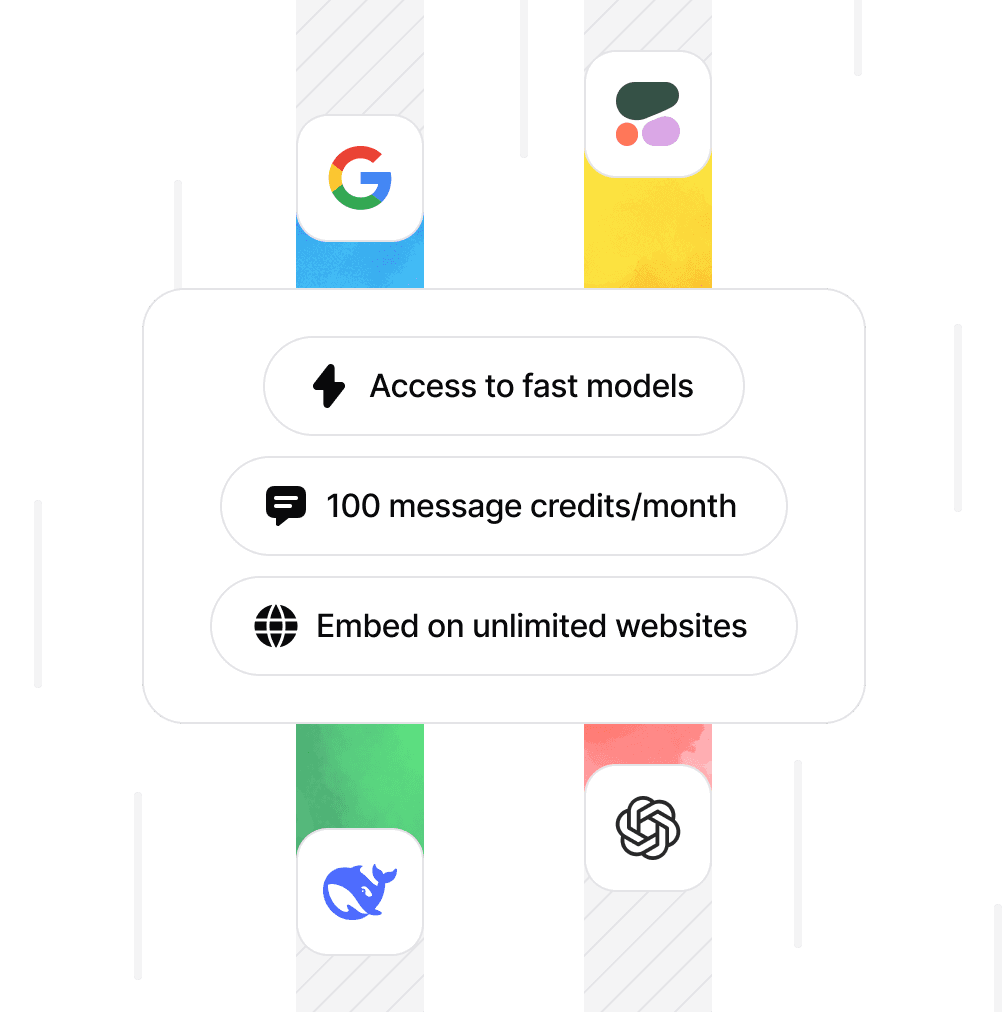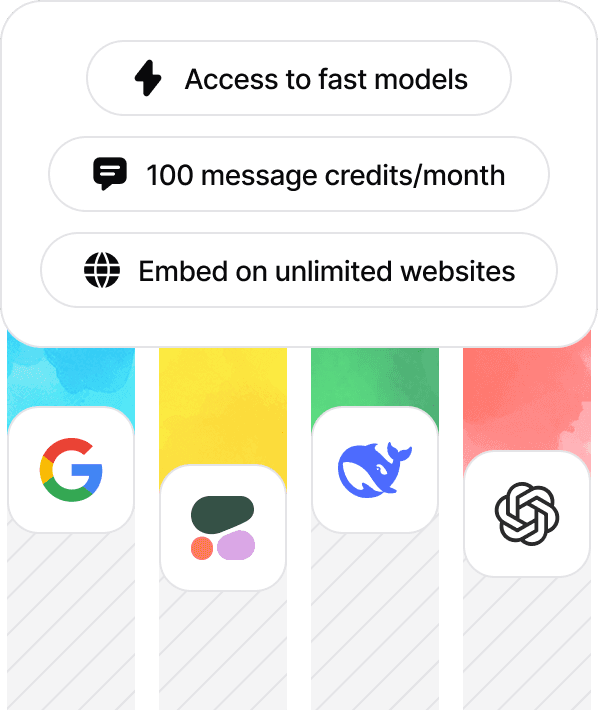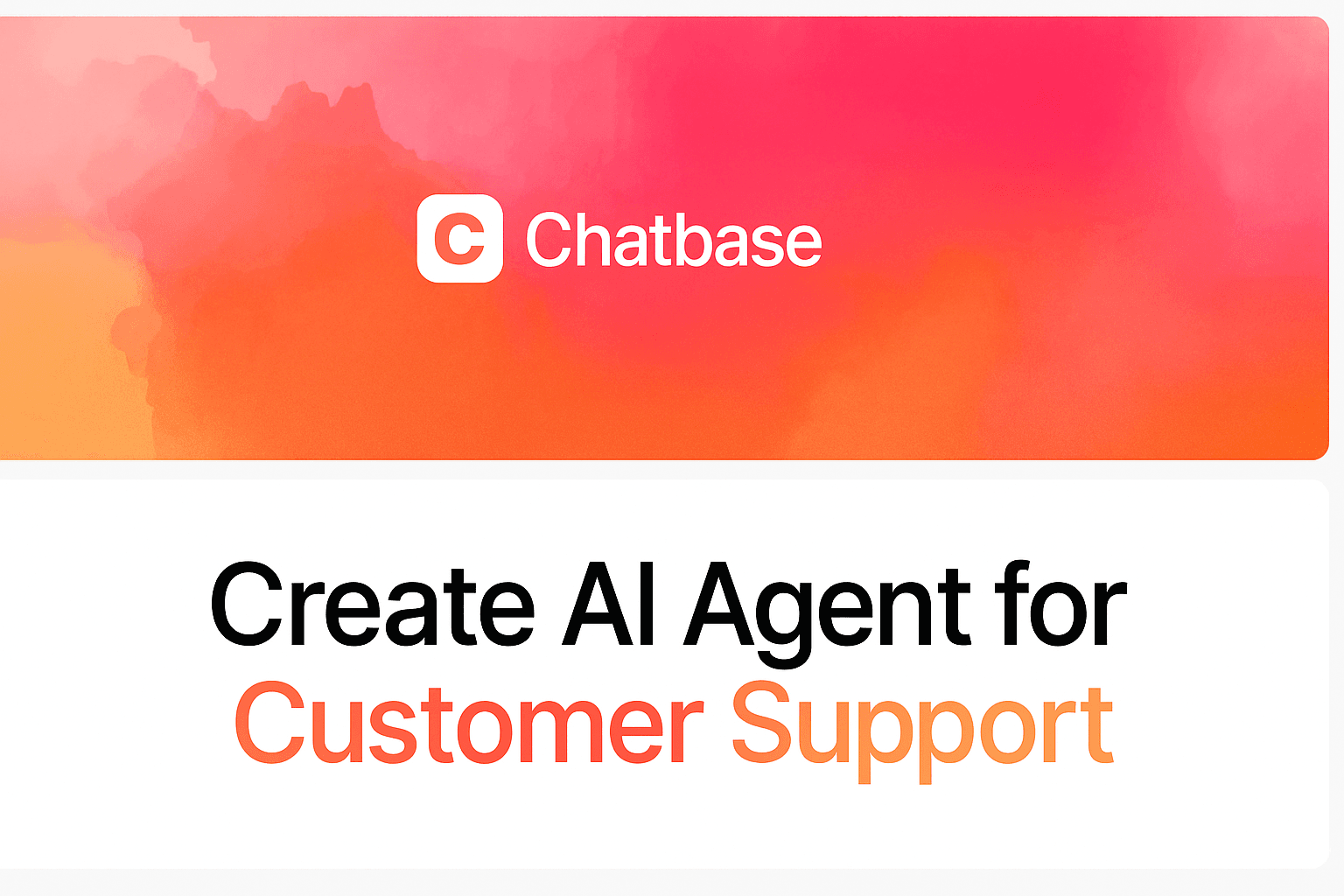AI in Customer Service: The Complete Guide for 2025
Ilias Ism
Nov 24, 2025
21 min read

82% of service pros say customer demands have increased. 78% of customers feel service is rushed. And you're expected to do more with less.
Sound familiar?
AI in customer service uses technologies like chatbots, virtual agents, and automated workflows to handle support inquiries faster and at scale, without requiring human intervention for every interaction. These tools use natural language processing (NLP) and machine learning to understand questions, retrieve relevant information, and deliver personalized responses 24/7.
The shift is already happening: Gartner predicts that by 2029, AI will autonomously resolve 80% of common customer service issues. Companies using AI report up to 30% cost reductions and 14% higher agent productivity.
This guide covers everything you need to know about AI in customer service: what it is, why it matters, practical use cases, implementation steps, and how to avoid common pitfalls.
TL;DR
What it is: AI customer service uses chatbots, virtual agents, and automation to handle support inquiries 24/7 without human intervention for every interaction.
Why it matters:
- Cost: Reduces cost per interaction from $15–$25 to $0.50–$2
- Speed: Responds in under 10 seconds vs. 2–5 minutes for humans
- Scale: One AI handles thousands of conversations simultaneously
- Results: 30–70% cost savings, 17% higher CSAT, 38% faster resolution
How to start: Upload your help docs to an AI platform like Chatbase, configure escalation rules, and launch with 25% of traffic. Full rollout in 4 weeks.
Bottom line: AI handles 80% of routine inquiries instantly. Humans handle 20% of complex cases, but with AI assistance, they're more productive than ever.
![[object Object]](/_next/image?url=https%3A%2F%2Fcdn.sanity.io%2Fimages%2Fi6kpkyc7%2Fprod-dataset%2Fb7c142f66022c3c9c3cf380ca183192d2f5f89d7-2752x1536.png&w=3840&q=75)
In this guide:
- What Is AI in Customer Service?
- Why AI in Customer Service Matters Now
- 8 Key Benefits of AI in Customer Service
- 10 Use Cases for AI in Customer Service
- How to Implement AI in Customer Service
- Will AI Replace Human Agents?
- Challenges and How to Overcome Them
- The Future of AI in Customer Service
- Getting Started
- FAQ
What Is AI in Customer Service?
AI in customer service refers to the use of artificial intelligence technologies to automate and enhance customer support operations. Instead of relying solely on human agents for every inquiry, AI-powered tools can:
- Answer common questions instantly via chatbots
- Route complex issues to the right team or agent
- Analyze customer sentiment to prioritize urgent cases
- Summarize conversations for faster agent handoffs
- Provide 24/7 support across multiple channels
The Technology Behind AI Customer Service
![[object Object]](/_next/image?url=https%3A%2F%2Fcdn.sanity.io%2Fimages%2Fi6kpkyc7%2Fprod-dataset%2F331fcdb8ab489ecc2939fc3a2fc7ac1ebcd449b1-2752x1536.png&w=3840&q=75)
Several technologies work together to power AI customer service:
Natural Language Processing (NLP) allows AI to understand human language: not just keywords, but intent and context. When a customer asks "Where's my order?" the AI understands they want tracking information, not a philosophical discussion about e-commerce.
Machine Learning (ML) enables AI to improve over time. Every interaction teaches the system what works and what doesn't. The more conversations it handles, the better it gets.
Retrieval-Augmented Generation (RAG) is the secret sauce behind modern AI chatbots. It works like this: when a customer asks a question, the AI searches your knowledge base, retrieves relevant information, and generates a response based on that specific context. Think of it as ChatGPT trained specifically on your company's data.
Conversational AI combines NLP and ML to create human-like back-and-forth conversations. Unlike basic chatbots that follow rigid scripts, conversational AI adapts to how customers actually communicate.
Sentiment Analysis detects customer emotions (frustration, satisfaction, confusion) in real-time. This helps prioritize angry customers and trigger escalations before situations deteriorate.
With Chatbase, all these technologies work together out of the box. You upload your help docs, website content, or Q&A pairs, and the AI learns your knowledge base using RAG. No coding required. You can go live in minutes.
Why AI in Customer Service Matters Now
Customer expectations have fundamentally shifted. According to the Salesforce State of Service Report:
- 82% of service professionals say customer demands have increased
- 78% of customers feel service interactions are rushed
- 81% expect a more personal touch than ever before
Traditional support models can't keep up. You can't hire fast enough, train quickly enough, or scale affordably enough to meet modern expectations.
The Business Case for AI
Here's what the numbers say:
- Cost per interaction: AI reduces costs from $15–$25 (human agent) to $0.50–$2 (AI-handled)
- Response speed: AI platforms respond in under 10 seconds. Human agents average 2–5 minutes.
- Scale: One AI agent handles thousands of conversations simultaneously. Humans handle one.
- Availability: AI works 24/7/365. No shifts, no breaks, no holidays.
According to IBM research, mature AI adopters report 17% higher customer satisfaction and 38% lower average call handling time.
The Trust Challenge (And Why It's Improving)
![[object Object]](/_next/image?url=https%3A%2F%2Fcdn.sanity.io%2Fimages%2Fi6kpkyc7%2Fprod-dataset%2Fbdc4753f8be30a380f68a497e6de072b1d391b7d-2752x1536.png&w=3840&q=75)
Here's the uncomfortable truth: customer trust in AI has been declining. According to Salesforce, only 42% of customers trust businesses to use AI ethically, down from 58% in 2023.
But the tide is turning. Recent industry discussions reveal a shift: "AI customer support is actually... good now?" is becoming a common sentiment among support professionals. The difference? Better implementations, smarter handoffs, and AI that actually solves problems instead of creating friction.
This doesn't mean trust will rebuild automatically. It means you need to implement AI thoughtfully:
- Be transparent when customers interact with AI
- Make it easy to reach a human agent
- Protect customer data with enterprise-grade security
- Use AI to enhance service, not replace human connection
Chatbase addresses these concerns with SOC 2 Type II and GDPR compliance, built-in human handoff, and customizable AI personalities that match your brand voice.
8 Key Benefits of AI in Customer Service
1. Faster Response Times
AI chatbots provide instant answers to common questions. No hold music. No "Your call is important to us" messages. Customers get what they need in seconds.
For complex issues, AI gathers context and routes to the right agent, reducing resolution time even when humans are involved.
2. 24/7 Availability
AI doesn't sleep. Customers in any timezone can get help at 2 AM or on holidays. This is critical for global businesses and e-commerce, where purchase decisions happen around the clock.
Learn more about implementing 24/7 support without hiring around-the-clock staff.
3. Lower Operational Costs
Automating routine inquiries (order status, password resets, return policies) reduces the volume human agents handle. Companies report 30–70% cost savings depending on automation rates.
One e-commerce company using Chatbase reduced their support costs by 60% while handling 3x more inquiries by automating 80% of repetitive questions.
Read our guide on how to cut customer support costs without sacrificing quality.
4. Improved Agent Productivity
AI handles the repetitive work, freeing agents for complex issues that require critical thinking. AI also assists agents in real-time with suggested responses, relevant knowledge articles, and conversation summaries.
Research from the National Bureau of Economic Research (NBER) shows customer support agents with AI assistance see 14% average productivity increases, with new agents improving up to 35%.
5. Consistent Service Quality
AI delivers the same accurate response every time. No variation based on agent experience, mood, or fatigue. This consistency builds customer trust.
With Chatbase, you control the AI's personality, tone, and response parameters, ensuring every interaction matches your brand voice.
6. Personalized Experiences
AI analyzes customer data (purchase history, past interactions, preferences) to tailor responses. Instead of generic answers, customers get relevant recommendations and context-aware support.
7. Scalability During Peak Demand
Product launches, holiday seasons, viral moments: AI handles sudden volume spikes without degrading service quality or requiring emergency hiring.
8. Data-Driven Insights
AI analyzes every conversation to identify trends: common issues, knowledge gaps, sentiment patterns. These insights help improve products, update documentation, and optimize support operations.
Chatbase provides built-in analytics that show you exactly what customers are asking, where the AI succeeds, and where it needs improvement.
10 Use Cases for AI in Customer Service
1. AI-Powered Chatbots for FAQs
![[object Object]](/_next/image?url=https%3A%2F%2Fcdn.sanity.io%2Fimages%2Fi6kpkyc7%2Fprod-dataset%2Fb941d78b26c770db482f205b7d452d7534e81414-2752x1536.png&w=3840&q=75)
Train a chatbot on your top 20 most common questions: order status, return policies, pricing, account issues. These often represent 60–80% of support volume.
With Chatbase, you upload your help docs, website content, or Q&A pairs. The AI learns your knowledge base and goes live in minutes with 95%+ accuracy.
Case Study: A SaaS company using Chatbase reduced their first-response time from 4 hours to under 30 seconds by automating FAQ responses. Their support team now focuses exclusively on complex technical issues, and CSAT increased from 72% to 89%.
2. AI Agents for Complex Inquiries
Modern AI agents go beyond simple Q&A. They can:
- Process returns and refunds
- Update account information
- Schedule appointments
- Handle multi-step troubleshooting
Unlike basic chatbots, AI agents understand context, maintain conversation history, and complete tasks autonomously.
3. Intelligent Ticket Routing
AI analyzes incoming requests and routes them to the right team based on topic, urgency, and customer value. No more manual sorting or misrouted tickets.
According to IBM, a global camping company using AI-powered routing saw a 33% increase in agent efficiency and reduced average wait time to just 33 seconds.
4. Agent Assist and Copilots
AI works alongside human agents, suggesting responses, surfacing relevant knowledge articles, and summarizing long conversation histories. Agents resolve issues faster with better information at their fingertips.
5. Sentiment Analysis and Prioritization
AI detects customer emotions in real-time. Frustrated customers get escalated faster. Satisfied customers might receive cross-sell recommendations.
Chatbase automatically flags negative sentiment and can trigger immediate escalation to human agents when needed.
6. Self-Service Knowledge Bases
AI enhances help centers by:
- Suggesting relevant articles based on customer queries
- Identifying content gaps and outdated information
- Generating new articles based on common questions
Learn how to build an effective AI knowledge base for your support team.
7. Voice AI and Smart IVR
AI-powered voice recognition replaces frustrating "Press 1 for..." menus. Customers describe their issue naturally, and AI routes them appropriately or resolves the issue directly.
A major UK bank implemented voice AI and saw a 150% boost in customer satisfaction for certain query types.
8. Proactive Customer Support
AI can predict issues before customers report them: flagging unusual account activity, upcoming subscription renewals, or potential service disruptions. Proactive outreach reduces inbound volume and increases satisfaction.
9. Automated Follow-Ups and Updates
After resolving an issue, AI sends follow-up emails, satisfaction surveys, or status updates automatically. This frees agents from administrative work while keeping customers informed.
10. Omnichannel Support
Deploy AI across live chat, email, social media, SMS, and voice, maintaining full conversation context across channels. Customers don't repeat themselves when switching from chat to phone.
Chatbase integrates with WhatsApp, Messenger, Instagram, Slack, and Zapier for seamless omnichannel deployment.
How to Implement AI in Customer Service
Step 1: Identify High-Impact Use Cases
Start with high-volume, low-complexity inquiries. Analyze your support data to find:
- Most frequently asked questions
- Repetitive tasks agents handle daily
- Long wait times or resolution bottlenecks
- Questions with clear, documented answers
Focus on use cases where AI delivers immediate ROI before expanding.
Step 2: Choose the Right AI Platform
Evaluate platforms based on:
- Accuracy: Pre-trained on customer service data, not just general language
- Integration: Connects with your CRM, helpdesk, and communication channels
- Setup time: No-code options vs. months of development
- Customization: Brand voice, tone, and policy controls
- Security: SOC 2, GDPR compliance, data encryption
Why Chatbase: No-code setup, live in minutes. Upload your docs and train a custom AI agent without developers. Used by 9,000+ companies across 140+ countries.
Learn more about automating customer support the right way.
Step 3: Prepare Your Knowledge Base
AI is only as good as the data it's trained on. Before launch:
- Audit existing help documentation for accuracy
- Fill content gaps for common questions
- Structure Q&A pairs for clear AI learning
- Remove outdated or conflicting information
Step 4: Build Human Escalation Paths
Not every issue should be handled by AI. Define clear escalation rules:
- Customer explicitly requests human agent
- AI confidence score falls below threshold
- Issue involves sensitive topics (billing disputes, complaints)
- Conversation exceeds complexity threshold
- Negative sentiment detected
Chatbase makes handoff seamless: the AI transfers full conversation context to human agents, so customers never have to repeat themselves.
Step 5: Test Before Full Launch
![[object Object]](/_next/image?url=https%3A%2F%2Fcdn.sanity.io%2Fimages%2Fi6kpkyc7%2Fprod-dataset%2F3632a8a2beac5f868712a7e9d968f8dfb4e0fd55-2752x1536.png&w=3840&q=75)
Run a pilot with a subset of traffic:
- Week 1: Internal testing, refine responses
- Week 2: 10–25% of live traffic
- Week 3: Expand to 50%, monitor metrics
- Week 4: Full rollout with ongoing optimization
Step 6: Monitor and Optimize
Track key customer service metrics:
- Resolution rate: % of issues resolved without human
- CSAT: Customer satisfaction after AI interactions
- First response time: How fast AI replies
- Escalation rate: % of conversations passed to humans
- Cost per interaction: Total cost / total conversations
Review conversations weekly to identify gaps, update training data, and improve responses over time.
Will AI Replace Human Agents?
Short answer: No.
Longer answer: AI changes what human agents do, not whether they're needed.
According to Salesforce, 66% of service leaders say their teams lack the skills needed to work with AI effectively. The challenge isn't AI replacing jobs: it's preparing teams for new ways of working.
What AI Handles Best
- High-volume, repetitive inquiries (FAQs, order status, password resets): learn how to automate FAQ responses
- 24/7 availability across time zones: see how to implement 24/7 support
- Initial triage and routing: explore automating customer support workflows
- Data gathering and context preparation: build an AI knowledge base for better context
- Post-interaction follow-ups: implement proactive customer service automation
What Humans Handle Best
- Complex, multi-faceted problems: understand when human agents excel
- Emotionally charged situations requiring empathy: learn when to escalate to humans
- High-stakes decisions and exceptions: see how AI and humans complement each other
- VIP and enterprise customer relationships: explore B2B customer service best practices
- Creative problem-solving and judgment calls: understand the hybrid AI-human model
The Hybrid Model
![[object Object]](/_next/image?url=https%3A%2F%2Fcdn.sanity.io%2Fimages%2Fi6kpkyc7%2Fprod-dataset%2F4ce7767849842bb5616efcc0500a357f413c8ee2-2752x1536.png&w=3840&q=75)
The most effective implementations combine AI efficiency with human connection:
AI handles 80% of routine interactions instantly. Humans handle 20% of complex cases, but now they have AI-generated summaries, suggested responses, and full context at their fingertips.
Chatbase supports this hybrid model with seamless human handoff. When a conversation needs escalation, the AI transfers everything (conversation history, customer sentiment, suggested next steps) to the human agent.
Learn more about AI chatbots vs. human customer service.
Challenges and How to Overcome Them
Building Customer Trust
The challenge: Only 42% of customers trust businesses to use AI ethically.
The solution:
- Be transparent. Tell customers when they're interacting with AI.
- Make reaching a human easy: never bury the escalation option.
- Explain how customer data is used and protected.
- Use AI to enhance service, not cut corners.
Chatbase is SOC 2 Type II certified and GDPR compliant. Learn more about our security practices.
Understanding Complex Requests
The challenge: AI can struggle with nuanced, multi-part questions or situations requiring deep context.
The solution:
- Build clear escalation paths for complex scenarios
- Train AI on your specific edge cases over time
- Use AI confidence scores to trigger handoffs
- Continuously review and improve training data
Data Quality and Training
The challenge: AI effectiveness depends on training data quality. Outdated, incomplete, or biased data produces poor results.
The solution:
- Audit your knowledge base before launch
- Update documentation regularly
- Monitor AI responses for accuracy
- Create feedback loops between agents and AI training
Integration Complexity
The challenge: Connecting AI to existing CRM, helpdesk, and backend systems can be technically challenging.
The solution:
- Choose platforms with native integrations
- Use APIs and webhooks for custom connections
- Start with standalone deployment, then integrate
Chatbase connects with Zendesk, Slack, Zapier, Stripe, WhatsApp, Messenger, and more out of the box.
The Future of AI in Customer Service
AI customer service is evolving fast. Here's where it's headed:
From Features to Infrastructure
The platforms winning in 2025 aren't just adding AI features: they're fundamentally reimagining customer service infrastructure. Gartner's latest Magic Quadrant for CRM Customer Engagement Centers reveals a seismic shift: the distinction between "CRM with AI" and "AI-native customer platforms" is becoming the defining competitive line.
This isn't abstract corporate tech. It's the infrastructure determining whether customer issues get resolved in 30 seconds or three transfers.
AI Agents, Not Just Chatbots
The next generation handles end-to-end tasks (issuing refunds, modifying orders, booking appointments) without human intervention. Gartner predicts 60% of enterprise service interactions will be fully managed by AI agents by 2030.
Proactive, Not Reactive
AI will anticipate customer needs before they ask: flagging potential issues, suggesting solutions, and reaching out proactively. The best support is the one customers never have to request.
Hyper-Personalization
AI will deliver truly individualized experiences based on real-time behavior, preferences, and history. Every interaction will feel tailored, not templated.
Emotional Intelligence
Advanced sentiment analysis will enable AI to adjust tone and approach based on customer emotions, responding with appropriate empathy. IBM reports that AI with emotional intelligence can improve satisfaction by 15% or more.
Voice-First Interactions
![[object Object]](/_next/image?url=https%3A%2F%2Fcdn.sanity.io%2Fimages%2Fi6kpkyc7%2Fprod-dataset%2F679827df3e0b64b5bc150e5efe9f408ba4832ace-2752x1536.png&w=3840&q=75)
Natural voice AI will replace traditional IVR systems, enabling conversational phone support that actually works.
Companies implementing AI now will build the data, workflows, and expertise needed to lead as these capabilities mature.
Getting Started with AI Customer Service
Ready to implement AI in your support operations? Here's a 4-week quickstart:
- Week 1: Identify top 20 FAQs, set up Chatbase, upload knowledge base
- Week 2: Configure AI personality and escalation rules, internal testing
- Week 3: Soft launch with 25% of traffic, monitor and refine
- Week 4: Full launch, establish optimization cadence
Chatbase makes this easy:
- No-code setup: live in under 10 minutes
- Upload help docs, websites, or Q&A pairs
- Integrates with Slack, WhatsApp, Messenger, Zendesk, Zapier
- Built-in analytics to track performance
- SOC 2 Type II and GDPR compliant
- Custom AI personality and brand voice
Join 9,000+ companies using AI to deliver faster, more scalable support.
👉 Start your free Chatbase trial: no credit card required.
FAQ
What is AI customer service?
AI customer service uses artificial intelligence technologies (chatbots, virtual agents, NLP, and machine learning) to automate support interactions. AI handles common inquiries, routes complex issues, and assists human agents with suggestions and summaries.
What is customer AI?
Customer AI refers to artificial intelligence systems designed specifically to understand, predict, and respond to customer behavior. It encompasses AI-powered tools for customer service (chatbots, virtual agents), customer analytics (predicting churn, identifying upsell opportunities), and personalization engines that tailor experiences based on individual preferences and history.
How does AI improve customer service?
AI delivers faster response times (seconds vs. minutes), 24/7 availability, consistent answers, and personalized experiences. It reduces operational costs while freeing human agents to focus on complex issues requiring judgment and empathy.
What are examples of AI in customer service?
Common examples include: AI chatbots for FAQs, intelligent ticket routing, agent assist tools, sentiment analysis, voice AI for phone support, proactive outreach, self-service knowledge bases, and automated follow-ups.
What is an example of AI in customer service?
A common example is an AI chatbot that handles order status inquiries. When a customer asks "Where's my order?", the AI uses natural language processing to understand the intent, retrieves real-time tracking data from your systems, and responds with the exact delivery status, all in under 10 seconds, 24/7, without human involvement. Companies like Sephora, H&M, and Bank of America use AI chatbots to handle millions of such inquiries monthly.
Is AI replacing human customer service agents?
No. AI handles routine, repetitive tasks, allowing human agents to focus on complex issues that require empathy, critical thinking, and judgment. The most effective implementations combine AI efficiency with human connection.
How much does AI customer service cost?
Costs vary by platform and usage. AI can reduce cost per interaction from $15–$25 (human agent) to $0.50–$2. Chatbase plans start at $19/month for businesses getting started, with enterprise options for high-volume needs.
How do I get started with AI customer service?
Identify your most common support questions
Choose an AI platform (like Chatbase) that integrates with your tools
Upload your knowledge base and configure the AI
Test with a subset of traffic before full launch
Monitor performance and optimize continuously
Is AI customer service secure?
Security depends on the platform. Look for SOC 2 Type II certification, GDPR compliance, data encryption, and clear data handling policies. Chatbase meets all these standards and never uses your data to train public models.
What industries benefit most from AI customer service?
AI customer service works across industries, but delivers the highest ROI for: e-commerce (order tracking, returns), SaaS (onboarding, technical support), financial services (account inquiries, transactions), healthcare (appointment scheduling, FAQs), and travel (bookings, changes, cancellations).
How do I talk directly to AI?
To get the best results from AI customer service:
Be specific and clear: state your issue directly ("I need to return order #12345" vs. "I have a problem")
Include relevant details: order numbers, account info, dates
Use neutral, polite language: AI responds better to clear requests than emotional language
Ask one question at a time: complex multi-part questions often get partial answers
If stuck, ask for a human: say "connect me to an agent" or "speak to a representative"
AI chatbots are trained on patterns, not emotions. Straightforward prompts produce more accurate responses than vague or emotionally-charged messages.
What skills are needed for AI customer service?
For implementing AI customer service, teams need: data management skills, basic understanding of AI/ML concepts, integration expertise (APIs, webhooks), and analytics capabilities to measure performance.
For human agents working alongside AI, five skills become essential:
Empathy: the human skill AI cannot replicate; critical for complex or emotional situations
Abstract problem-solving: handling edge cases and novel issues that fall outside AI training
Cultural adaptability: understanding nuance across different customer backgrounds
Contextual judgment: knowing when to override AI recommendations
Innovation: identifying process improvements and new AI training opportunities
As AI handles routine tasks, human agents increasingly focus on high-complexity interactions where these skills differentiate great service from adequate service.
Share this article:







